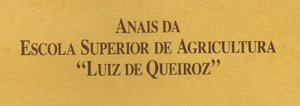Resumo
This paper deals with the variation of the ascorbic acid content in Natal orange as related to the type of rootstock and to the picking time. The determinations were carried out in the juice of fruits which had practically the same ratio total solids/acidity being selected only the highest values of such quotient. The results can be summaryzed as follows: 1. The rootstock has a significant influence on the vitamin C content of the scion; this influence shows two interesting aspects: first, the ascorbic acid contet itself varies as a function of the rootstock; among the three rootstocks studied the highest values were obtained on scion growing on Serra d'água orange; the lowest values were found in "limão rugoso" and "limão francês" was intermediate; the second point to be emphasyzed is the manner of variation of the ascorbic acid content in the different rootstocks: in the case of Serra d'água. the content decreases slowly whereas in "limão francês" the level remains nearly constant and suddenly falls down; finally in the case of "limão rugoso" the amount of ascorbic acid increases significantly to return to the primitive level. 2. The amount of ascorbic acid, not considering the rootstock influence, varies strongly as a function of harvesting time; for this reason the present factor must be borne in mind when sampling for the determination of ascorbic acid in orange is concerned.
ISecção de Genética, E. S. A. "Luiz de Queiroz", U. S. P
IISecção de Tecnologia Agrícola, E. S. A. "Luiz de Queiroz", U. S. P
IIISecção de Química Agrícola, E. S. A. "Luiz de Queiroz", U. S. P
IVSecção de Horticultura, E. S. A. "Luiz de Queiroz", U. S. P
SUMMARY
This paper deals with the variation of the ascorbic acid content in Natal orange as related to the type of rootstock and to the picking time. The determinations were carried out in the juice of fruits which had practically the same ratio total solids/acidity being selected only the highest values of such quotient. The results can be summaryzed as follows:
1. The rootstock has a significant influence on the vitamin C content of the scion; this influence shows two interesting aspects: first, the ascorbic acid contet itself varies as a function of the rootstock; among the three rootstocks studied the highest values were obtained on scion growing on Serra d'água orange; the lowest values were found in "limão rugoso" and "limão francês" was intermediate; the second point to be emphasyzed is the manner of variation of the ascorbic acid content in the different rootstocks: in the case of Serra d'água.
the content decreases slowly whereas in "limão francês" the level remains nearly constant and suddenly falls down; finally in the case of "limão rugoso" the amount of ascorbic acid increases significantly to return to the primitive level.
2. The amount of ascorbic acid, not considering the rootstock influence, varies strongly as a function of harvesting time; for this reason the present factor must be borne in mind when sampling for the determination of ascorbic acid in orange is concerned.
Texto completo disponível apenas em PDF.
Full text available only in PDF format.
LITERATURA CITADA
- LEME Jr., J. e E. MALAVOLTA. 1950. Determinação fotométrica do ácido ascórbico. An. E. S. A. "Luiz de Queiroz", U. S. P. 7: 115-129.
Influência de diferentes cavalos e da época de colheita no teor de vitamina C na laranja natal
Datas de Publicação
-
Publicação nesta coleção
01 Nov 2012 -
Data do Fascículo
1953

